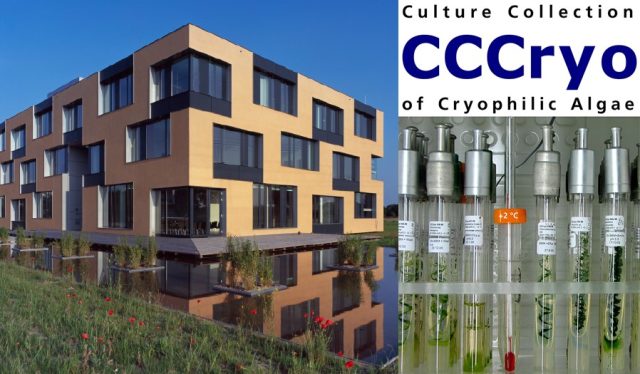- Collection name: Culture Collection of Cryophilic Algae
- Acronym: CCCryo
- WDCM number: 940
- Institution: Fraunhofer Institute for Cell Therapy and Immunology; Branch Bioanalytics and Bioprocesses IZI-BB; Extremophile Research & Biobank CCCryo
- Address:
Am Muehlenberg 13
14476 Potsdam
Germany - Website: https://cccryo.fraunhofer.de
Website of the catalogue or database of the collection: - Correspondence data: https://cccryo.fraunhofer.de/web/strains/
E-mail: thomas.leya@izi-bb.fraunhofer.de
Tel.: +49 331 58187-304
Correspondent: Dr. Thomas Leya
Members holdings
Group(s) of biological resources stored in the collection: cyanobacteria, yeasts, filamentous fungi, eukaryotic algae, mosses
The CCCryo and its workgroup Extremophile Research has a strong focus on cryophilic (= cold-loving) freshwater microalgae, i.e. snow and permafrost algae from polar and alpine environments. Both are located at the Fraunhofer IZI-BB in Potsdam. Fraunhofer is a non-profit research organisation. The CCCryo currently holds 533 strains from 176 species in 981 genera. We cover mainly freshwater microalgae but also maintain cyanobacteria and a minor number of fungi, eubacteria and mosses. Strains from cold habitats are cultured at +2 °C, other strains at +15 or +32 °C in the case of e.g. thermophilic cyanobacteria. The algal classes of the Chlorophyceae and Trebouxiophyceae dominate the CCCryo, however, also many Cyanophyceae, Zygnematophyceae, Xanthophyceae and Bacillariophyceae have been isolated from snow and ice. The CCCryo with its specialisation on cryophiles is unparalleled in its scope and diversity and serves the worldwide scientific community.
CCCryo is known for the high quality of its strains. Strains are transferred to fresh agar slants every 1-12 months depending on their specific growth rate. Before each serial transfer the "old" agar slant is inspected using a binocular to detect obvious contaminations. At least every 2 years each strain is tested for contaminations using test media rich in organic components (beef extract, yeast extract, glucose, proteose peptone) and when in doubt, further light microscopical inspections are performed. Contaminated strains are purified using single cell isolation, streaking, spraying or dilution techniques. Only in very rare cases we apply antibiotics. All CCCryo strains are unialgal, and approximately 2 thirds are axenic (free from contaminating bacteria and fungi). Nearly 80 % of our strains are cryopreserved in our own cryopreservation facility (not all have been tested for survival though - that is why we rely on a live biobank). Of those strains being cryopreserved, we have a backup at the Fraunhofer IBMT in Sulzbach (Germany).

